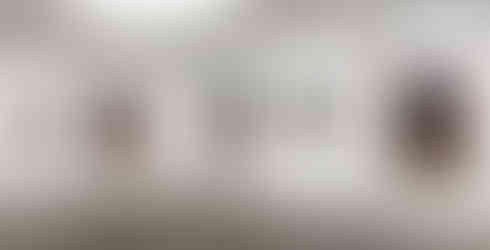The quiet wisdom of the grotesque
- Hüseyin Gökçe
- 45 dakika önce
- 5 dakikada okunur
Evgenia Saré’s solo exhibition Zyuziki is on view at Galeri 77 from October 23 to December 7, 2025. We spoke with the artist about the world her grotesque figures build through tenderness and vulnerability
Interview: Hüseyin Gökçe

Evgenia Saré. Photo: Arman Karakhanyan
The images consist of grotesque combinations. Figures celebrating each other’s existence live a shared life. To what extent did eccentricity play a role in the existence of such a life?
I feel that all of my creative work has, in some way, been “scripted” by the theater. My involvement in productions built upon diverse literary foundations could not help but leave its imprint on my art. The very notions of play, disguise, metamorphosis, carnival, masquerade, and prank are quintessentially theatrical. I delight in these games, and their essence is ever-present in my paintings.
Is the grotesque a characteristic of the body? Or is it the peculiarities left on the body by the levels of encounter?
My characters, the “zyuziks”, may seem grotesque at first glance. But they grow on you; in fact, they can and should be loved for their gentleness, their contemplative nature, their quiet wisdom. They inhabit a world much like ours, yet cleansed of malice, envy, and aggression. And once you enter that world, you stop noticing their small distortions because those aren’t their defining traits.
Left: Evgenia Saré, Portrait de famille, 2019, Oil on canvas, 81 x 100 cm
Right: Evgenia Saré, Photo De Classe, 2015, Oil on canvas, 81 x 100 cm
The perspective on beauty is shaped by perfection, harmony, and general acceptance. The grotesque is perceived as flawed, incompatible, bizarre, and undesirable. While imperfection is inherent in this upside-down world, what makes us avoid the grotesque?
We avoid the grotesque out of fear of looking in the mirror.
The heartbeats of figures composed of strange, mischievous, hybrid, plump, sometimes long, thin hands, faces, noses, and clothes seem to beat with a naivety that will not break or hurt each other. Do you think you idealize the grotesque?
I don’t idealize the grotesque; I use it to reveal human vulnerability, emotional fragility, and our defenselessness in the face of a critical or judgmental gaze.

Evgenia Saré, Nourrice, 2019, Oil on canvas, 81 x 100 cm
You live in Paris. The world is becoming increasingly uniform and homogeneous. Have you ever had the chance to encounter weird characters?
Of course, and not just me. Look closely around you: in almost all human beings, you’ll find traces of a “zyuzik.” They’re recognizable, sometimes funny, pensive, melancholic but always kind-hearted. They observe us quietly, wiser than we are, and they seem to know something about us that we ourselves have yet to discover.
Is the technique and form you use in your works more necessary to create the elements that give rise to grotesque characters, or to bring them to life in a space?
The technique in which I work is one I have learned from the old masters. It demands more time than many of today’s hurried methods, dictated by the relentless pace of modern life. I do not rush; I allow myself the space to reflect. Moreover, this technique grants me the joy of lingering over the smallest details, a process from which I draw particular pleasure.
From left to right: Evgenia Saré, Marionnettes, 2023, Oil on canvas, 160 x 120 cm (Polyptych)
Evgenia Saré, Nuit, 2023, Oil on canvas, 146 x 114 cm
Evgenia Saré, Masques, 2021, Oil on canvas, 150 x 100 cm (Diptych)
I know you are interested in the techniques of the Old Masters. These men all have an important place in art history. They are all presented as geniuses. The history of women artists is invisible because it is overwhelmingly historicized. What would you like to say about this problematic structure of art history?
The history of art is no different from the histories of sciences, inventions, and so forth. In every field, the role of women has been obscured, dictated by social conditions. Perhaps one day this will change; at the very least, one hopes to believe in such a future.
Among the artists who inspire you are Bosch, Bruegel, Callot, Daumier, and even Goya. How often do you visit museums to see their works? Have you ever noticed a detail or mistake in their works that you hadn’t seen before?
Outstanding works are distinguished precisely by the fact that each time you encounter them, you discover something new. We change, and our perception changes with us; what seemed insignificant yesterday may become essential today, and thus our perception evolves. Sometimes the eye latches onto a detail that might seem like a “mistake” , but perhaps it was intentional, inviting reflection and personal interpretation. Anything that makes us think in front of a painting is a gift. After all, that is one of art’s true purposes.

Evgenia Saré, Domino, 2019, Oil on canvas, 40 x 120 cm
For me, Goya holds a special place among these artists. He showed the courage to darken the landscape in his works. The moods and gazes of the figures become so clear that we are left face to face with the reality of what we live alongside in the world. There is no other way out but to cling to life hopelessly. I wonder how you view Goya.
I admire Goya, although I do not share his sense of the total tragedy of human existence.
The figures in the works seem unwilling to abandon compassion for even a moment. They whisper to us the necessity of not letting go of compassion, no matter what situation or conditions we find ourselves in. Where does the compassion in your works come from?
Probably from the feeling of human vulnerability. Given what is happening in the world today, we all need compassion. If everyone felt this way, the world would be a much better place to live.

Evgenia Saré, Bas les Masques, 2024, Oil on canvas, 73 x 116 cm
Francis Bacon was interested in the head in a Deleuzian sense. He problematized it as the indistinguishable place between human and animal. Bacon had a keen interest in slaughterhouses. In my opinion, he worked on his art near slaughterhouses rather than in a studio. He captured in his paintings the knives thrown by the butcher as he slaughtered an animal and the screams and moments of silence that emerged at that moment. Where do you create your art?
Bacon is one of the most traumatised and traumatising artists of the 20th century.
We all see the horrors and tragedies around us; we cannot help but see them. The artist then has two paths to choose from: either to cultivate these tragedies, to some extent glorifying them and thereby multiplying them, or at least to try to bring something of their own to the table, in an often-unsuccessful attempt to make the world a kinder and wiser place. “Créer, c'est résister à ce qui entend contrôler nos vies.” (“To create is to resist what seeks to control our lives.”) This is Deleuze’s formulation, and every artist resists in the way they deem possible for themselves. The most important part of my work is the preparatory sketches. I work on them in a notebook, which can happen anywhere. When I am alone with my notebook, the world around me disappears. This is the stage of work when the future painting is born. When the idea for the painting has matured, I go to my studio and start working on the canvas, knowing exactly what will appear on it. I enjoy my work, and I am happy when my work makes people smile.























